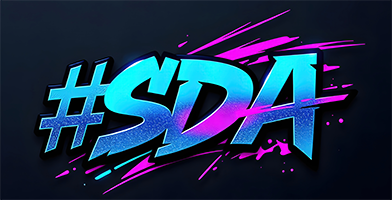SDA History: Stepping Out of the Past, Into the Future
Early ‘90s:
The Art of Connection
Before social media and digital galleries, there were BBS networks—underground hubs where ANSI art thrived in the wild, unregulated days of the pre-internet era. With no centralized platforms to showcase work, artists built their own distribution networks, spreading their creations across the boards they loved.
Silicon Dream Artists (SDA) emerged in 1991 as a collective of digital artists pushing the limits of early computer graphics. Using text-mode art, they transformed ANSI code into full-scale visuals, distributing them across BBS networks where creativity and connection went hand in hand.
It started with Master of Abstraction and Illusion (MAI), founded by Soul Keeper, which produced DOS-based ANSI "review" magazines covering games and digital culture. In late ‘91, MAI merged with Mega Byte's Maximized ANSi Designers (MaD) to form Silicon Dream Artists. Shortly after the merger, Force Ten negotiated a leadership change to stabilize the transition between the two groups, establishing a "Tri-Prez" structure between himself, Shadow PhanTom, and Toxic Marshmallow. Under their leadership, SDA expanded to new boards and established additional HQs, strengthening its presence across the BBS scene.
SDA didn’t last as long as ANSI giants like iCE or ACiD, but for a brief moment, it was everywhere. With a nationwide distribution system, four HQs, multiple distro sites, and a roster of nearly 40 artists over its lifetime, including prolific names like The Renegade Chemist, Tornado, The Weeze, and Paul Maud’dib, SDA produced over 200 works and made an outsized impact before burning out just as fast.
Turning Point:
The USA Bust
& The Fall of SDA
Like everything in the underground, the scene had risks. The art and warez worlds were deeply intertwined—not because SDA was a warez group, but because unregulated networks were the best places for digital art to exist.
In early 1992, the USA group bust sent shockwaves through the community. SDA had deep ties in the scene, and as pressure mounted, many members questioned whether to stay involved. The fallout was unavoidable. Some members left entirely, others shifted focus, and SDA, once thriving, began to fade.
By 1993, SDA had released its final works and disbanded without an official statement. Some artists reformed under new banners like GRiM, and Rivendell—one of SDA’s legendary boards—became an iCE distro site. The ANSI scene was changing, and the transition from BBS to FTP and early web distribution signaled the end of an era.
But the challenges artists faced back then haven’t disappeared—they’ve only evolved.
SDA 2024:
A New Chapter
For those who lived the underground BBS era, SDA was about creation, distribution, and seeing your work in the places you traveled. Now, we’re doing it again, but this time, we’re taking it beyond digital.
The networks are bigger. The tools are more advanced. The possibilities are endless.
SDA built the networks before. Now, we’re doing it again, opening new spaces for independent artists to share their work, explore new ideas, and bring digital art to life in exciting new ways.
